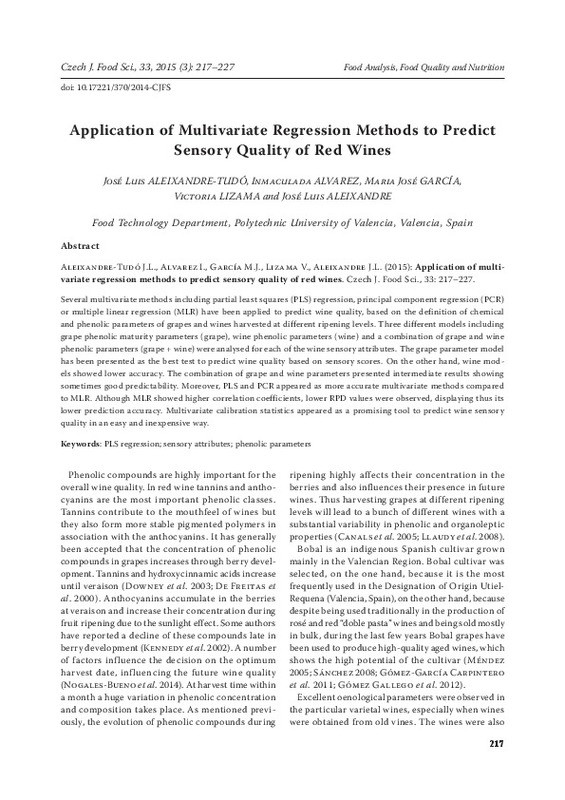JavaScript is disabled for your browser. Some features of this site may not work without it.
Buscar en RiuNet
Listar
Mi cuenta
Estadísticas
Ayuda RiuNet
Admin. UPV
Application of Multivariate Regression Methods to Predict Sensory Quality of Red Wines
Mostrar el registro sencillo del ítem
Ficheros en el ítem
| dc.contributor.author | Aleixandre Tudo, José
|
es_ES |
| dc.contributor.author | Alvarez Cano, María Inmaculada
|
es_ES |
| dc.contributor.author | García Esparza, Mª José
|
es_ES |
| dc.contributor.author | Lizama Abad, Victoria
|
es_ES |
| dc.contributor.author | Aleixandre Benavent, José Luís
|
es_ES |
| dc.date.accessioned | 2016-07-12T07:38:58Z | |
| dc.date.available | 2016-07-12T07:38:58Z | |
| dc.date.issued | 2015 | |
| dc.identifier.issn | 1212-1800 | |
| dc.identifier.uri | http://hdl.handle.net/10251/67439 | |
| dc.description | Copyright - Czech Academy of Agricultural Sciences The original publication is available on http://agriculturejournals.cz/web/cjfs.htm | es_ES |
| dc.description.abstract | Several multivariate methods including partial least squares (PLS) regression, principal component regression (PCR) or multiple linear regression (MLR) have been applied to predict wine quality, based on the definition of chemical and phenolic parameters of grapes and wines harvested at different ripening levels. Three different models including grape phenolic maturity parameters (grape), wine phenolic parameters (wine) and a combination of grape and wine phenolic parameters (grape + wine) were analysed for each of the wine sensory attributes. The grape parameter model has been presented as the best test to predict wine quality based on sensory scores. On the other hand, wine models showed lower accuracy. The combination of grape and wine parameters presented intermediate results showing sometimes good predictability. Moreover, PLS and PCR appeared as more accurate multivariate methods compared to MLR. Although MLR showed higher correlation coefficients, lower RPD values were observed, displaying thus its lower prediction accuracy. Multivariate calibration statistics appeared as a promising tool to predict wine sensory quality in an easy and inexpensive way. | es_ES |
| dc.language | Inglés | es_ES |
| dc.publisher | CZECH ACADEMY AGRICULTURAL SCIENCES | es_ES |
| dc.relation.ispartof | Czech Journal of Food Sciences | es_ES |
| dc.rights | Reserva de todos los derechos | es_ES |
| dc.subject | PLS regression | es_ES |
| dc.subject | Sensory attributes | es_ES |
| dc.subject | Phenolic parameters | es_ES |
| dc.subject.classification | TECNOLOGIA DE ALIMENTOS | es_ES |
| dc.title | Application of Multivariate Regression Methods to Predict Sensory Quality of Red Wines | es_ES |
| dc.type | Artículo | es_ES |
| dc.identifier.doi | 10.17221/370/2014-CJFS | |
| dc.rights.accessRights | Abierto | es_ES |
| dc.contributor.affiliation | Universitat Politècnica de València. Departamento de Tecnología de Alimentos - Departament de Tecnologia d'Aliments | es_ES |
| dc.description.bibliographicCitation | Aleixandre Tudo, J.; Alvarez Cano, MI.; García Esparza, MJ.; Lizama Abad, V.; Aleixandre Benavent, JL. (2015). Application of Multivariate Regression Methods to Predict Sensory Quality of Red Wines. Czech Journal of Food Sciences. 33(3):217-227. https://doi.org/10.17221/370/2014-CJFS | es_ES |
| dc.description.accrualMethod | S | es_ES |
| dc.relation.publisherversion | https://dx.doi.org/10.17221/370/2014-CJFS | es_ES |
| dc.description.upvformatpinicio | 217 | es_ES |
| dc.description.upvformatpfin | 227 | es_ES |
| dc.type.version | info:eu-repo/semantics/publishedVersion | es_ES |
| dc.description.volume | 33 | es_ES |
| dc.description.issue | 3 | es_ES |
| dc.relation.senia | 290776 | es_ES |
| dc.identifier.eissn | 1805-9317 |








